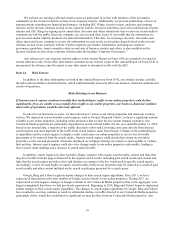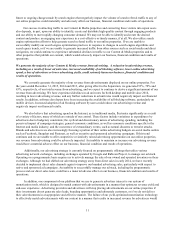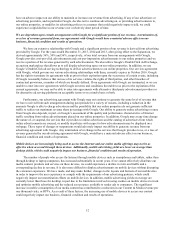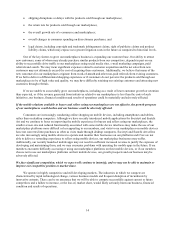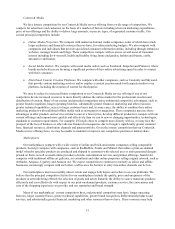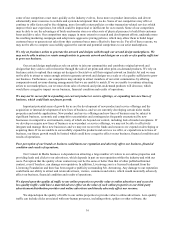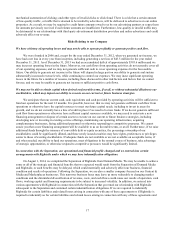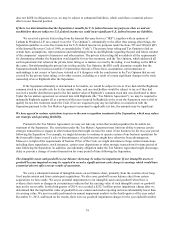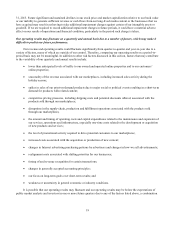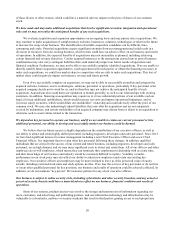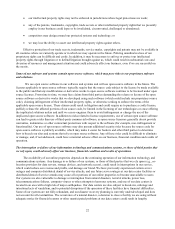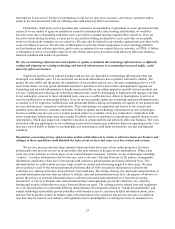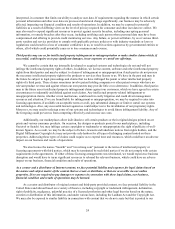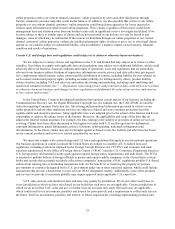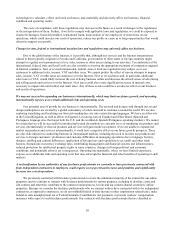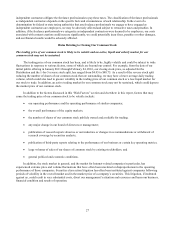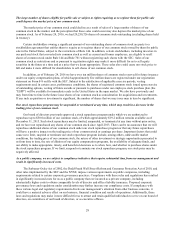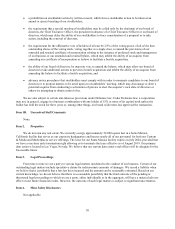Enom 2015 Annual Report Download - page 22
Download and view the complete annual report
Please find page 22 of the 2015 Enom annual report below. You can navigate through the pages in the report by either clicking on the pages listed below, or by using the keyword search tool below to find specific information within the annual report.20
of those factors or other reasons, which could have a material adverse impact on the price of shares of our common
stock.
We have made and may make additional acquisitions that involve significant execution, integration and operational
risks and we may not realize the anticipated benefits of any such acquisitions.
We evaluate acquisition and expansion opportunities on an ongoing basis and may pursue select acquisitions. We
may continue to make acquisitions of complementary websites, businesses, solutions, technologies or talent in the future
to increase the scope of our business. The identification of suitable acquisition candidates can be difficult, time-
consuming and costly. Potential acquisitions require significant attention from our management and could result in a
diversion of resources from our existing business, which in turn could have an adverse effect on our business and results
of operations. In addition, the expected benefits of acquisitions may not materialize as planned, including achieving
certain financial and revenue objectives. Certain acquired businesses or the transactions entered into as part of business
combinations may also carry contingent liabilities that could materially impact our future results of operations and
financial condition. Furthermore, we may not be able to successfully complete identified acquisitions. If we are unable to
identify suitable future acquisition opportunities, reach agreement with such parties or obtain the financing necessary to
make such acquisitions, we could lose market share to competitors who are able to make such acquisitions. This loss of
market share could negatively impact our business, revenue and future growth.
Even if we successfully complete an acquisition, we may not be able to successfully assimilate and integrate the
acquired websites, business, assets, technologies, solutions, personnel or operations, particularly if key personnel of an
acquired company decide not to work for us, and we therefore may not achieve the anticipated benefits of such
acquisition. Acquisitions also could harm our reputation or brands generally, as well as our relationships with existing
customers. In addition, financing an acquisition may require us to (i) use substantial portions of our available cash on
hand, (ii) incur additional indebtedness, which would increase our costs and impose operational limitations, and/or
(iii) issue equity securities, which would dilute our stockholders’ ownership and could adversely affect the price of our
common stock. We may also unknowingly inherit liabilities that arise after the acquisition and are not adequately
covered by indemnities, and certain stockholders of an acquired company may dissent from or object to an acquisition or
otherwise seek to assert claims related to the transaction.
We depend on key personnel to operate our business, and if we are unable to retain our current personnel or hire
additional personnel, our ability to develop and successfully market our business could be harmed.
We believe that our future success is highly dependent on the contributions of our executive officers, as well as
our ability to attract and retain highly skilled personnel, including engineers, developers and sales personnel. Since 2013,
we have had significant turnover in senior management including a new Chief Executive Officer and a new Chief
Financial Officer. It is important that we retain other key personnel following these changes. In addition, qualified
individuals that are critical to the success of our current and future business, including engineers, developers and sales
personnel, are in high demand, and we may incur significant costs to attract and retain them. All of our officers and other
employees are at-will employees, which means they can terminate their employment relationship with us at any time,
and their knowledge of our business and industry would be extremely difficult to replace. Volatility or under-
performance in our stock price may also affect our ability to attract new employees and retain our existing key
employees. Our executive officers and employees may be more inclined to leave us if the perceived value of equity
awards, including restricted stock units and stock options, decline. If we lose the services of key personnel or do not hire
or retain other qualified personnel for key positions, our business and results of operation could be adversely affected. In
addition, we do not maintain “key person” life insurance policies for any of our executive officers.
Our business is subject to online security risks, including cyberattacks and other security breaches, and any actual or
perceived security breach could have a material adverse effect on our business, financial condition and results of
operations.
Some of our systems, products and services involve the storage and transmission of information regarding our
users, customers, and advertising and publishing partners, and our information technology and infrastructure may be
vulnerable to cyberattacks, malware or security incidents that result in third parties gaining access to such proprietary


